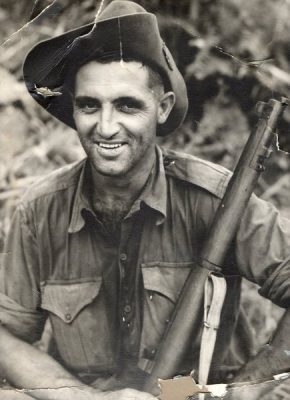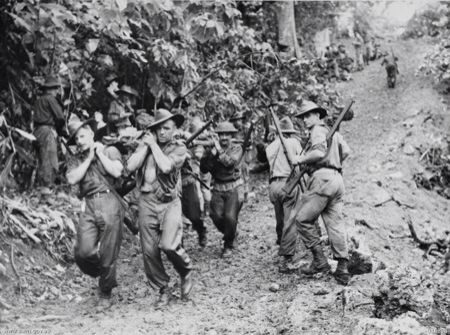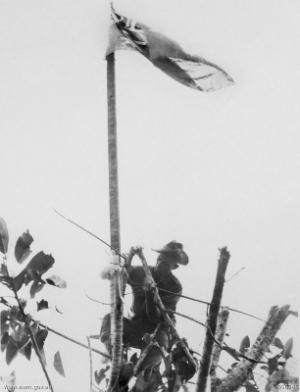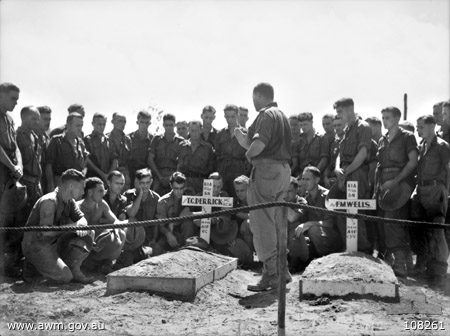Sattelberg: A VC for Australia’s toughest soldier

One of Australia’s true war heroes was a poet and butterfly collector.
The annals of Australian military history are chock full of tales of heroism and derring-do and every so often a new hero arises from these vast volumes. Words: Roderick Eime
Thomas Currie ‘Diver’ Derrick was one such soldier who rose to ‘rock star’ status among the Australian Imperial Force (AIF) in WWII but has since faded from our memories.
Born in Adelaide in 1914 to poor parents on the rough side of town, Derrick quickly learned to live by his wits - and his fists. He struggled through the depression earning money as a labourer and fruit picker and married his childhood sweetheart, Beryl, in 1939. Derrick enlisted in 1940 as a private in the mostly South Australian 2/48th Battalion of the soon to be famous 9th Division.
From the get-go, Derrick proved himself an exceptional soldier and a tough, intelligent, quick-thinking leader. He served with distinction in the North African campaign as part of the British Eighth Army and quickly rose to the rank of sergeant. Many close to the action thought Derrick was a walk-up start for a VC after his exceptional exploits at Tel el Eisa in the early part of the El Alamein campaign. He was, however, later awarded the Distinguished Conduct Medal (DCM).
Wounded and lucky to survive, he was evacuated with many of his unit in October 1942 as the famous battle reached its climax. The 2/48 suffered devastating casualties during this period and returned to Australia aboard the troopship Nieuw Amsterdam on 24 January 1943.
Through the early part of 1943, the Australian 9th Division was rested, re-equipped and rebuilt. They trained hard near Cairns for their next call of duty in the unforgiving jungles of Papua New Guinea against an enemy known for fanatical and merciless fighting.
It was here in the steamy, mosquito-infested swamps and jungles around Lae and Finschhafen that Derrick and the 2/48 again proved their mettle, with Lae falling to Australian troops ahead of schedule on the 16th of September. The commanders were quick to exploit their advantage and inflicted heavy casualties on the retreating Japanese forces who were withdrawing to high ground away from the coast.
Under command of the ambitious and unforgiving Australian General Sir Thomas Blamey, Finschhafen fell on October 2, but not before strong Japanese forces could withdraw eight kilometres to the north-west and regroup on the high ground around Sattelberg where the German Lutheran missionaries had set up a station in the late 1800s.
Because of the massed Japanese forces, found to be about 5,000 strong despite intelligence estimates that put the number as low as 350, it was clear Sattelberg had to be dealt with before further advances could be made by the Australian forces. What Allied intelligence had overlooked was the reinforcements and heavy weapons brought in from Madang and surrounding garrisons to bolster the Sattelberg citadel.
It was mid-November before the Australians began their attack in arduous and difficult terrain. Moving in the Matilda tanks and 24-pounder artillery was almost impossible in these conditions and sappers worked tirelessly to get these vital elements in position.
But in the end, with the Matildas stuck and disabled, it was the foot soldiers, lead by men like Sgt Derrick who had to do the heavy lifting. And heavy it was.

Machine guns, mortars and grenades were raining havoc down on them from a position they dubbed Coconut Ridge. Casualties were mounting on both sides and the battle was intense for every few metres of progress. Finally the Australians were able to secure the ridge and move toward their ultimate objective of the mission atop the summit, but again stiff resistance was encountered by dug-in Japanese defenders.
Sgt Derrick was leading a platoon (about 40 men) and with victory within his grasp he pushed on up steep slopes through thick kunai grass but was thwarted by both the precipitous terrain, failing light and hand grenades lobbed on him from above. When he reported slow progress to his commander, he was told to withdraw and have another go in the morning. Impatient and intensely competitive, Derrickcreatively avoided following his orders and with a few hand-picked men supporting him with small arms, proceeded to personally destroy the ten troublesome positions, throwing grenades like cricket balls from just a few metres away.
By the time darkness had set in, all were on the brink of exhaustion and fifty attackers were dead with many more wounded. The few surviving defenders had withdrawn and Derrick decided they could take a break, so he and his men held that position until daybreak.
At dawn, a final barrage ensured the last defenders had either fled or been killed and the Australians marched triumphantly onto the summit where the honour of raising the flag was reserved for Sgt. Derrick.

The 1st Tank Battalion, 2/23rd Battalion, 2/24th Battalion, 2/48th Battalion and the 2/2nd Machine Gun Battalion were all awarded the battle honour ‘Sattelberg’.
This action secured his VC and was announced in The London Gazette the following March. The lengthy description of his heroic act was summed up with the final paragraph:
Undoubtedly Sergeant Derrick's fine leadership and refusal to admit defeat, in the face of a seemingly impossible situation, resulted in the capture of Satelberg. His outstanding gallantry, thoroughness and devotion to duty were an inspiration not only to his platoon and company but to the whole Battalion.
Already something of a celebrity soldier within the 9th Division, this last act, soon known as 'Derrick's Show', secured him wide acclaim and public notoriety.
With such intense battle experience under his belt in a war that had seen him spend the last four Christmases on foreign, often hostile soil, it would be easy to understand Derrick’s growing battle fatigue. The tough digger had recovered from numerous wounds as well as malaria and even went on to officer training, rejoining the 2/48th as Lt. Derrick against the strict army protocol for officers drawn from the ranks not returning to their original units. His subsequent return to duty on Boxing Day 1944 was met with “great jubilation”.
"l suppose I'd better keep my head down this time, dad," he told his father as set off on his final tour.
Tough as nails perhaps, and witness to untold horrors of war, Derrick was a complex individual. He wrote poetry, composed loving letters to his wife, kept a meticulous diary and even found time to collect butterflies.
When the war was in its final months, the 2/48th was sent to Borneo to recapture the valuable oil fields around Tarakan. Of these last desperate defenders who had no intention of surrendering, he is quoted as saying he’d "never struck anything so tough as the Japanese on Tarakan."
In May 1945 he led a successful attack but was struck by a burst of machine gun fire from an unseen position. In great pain and knowing his wounds were fatal, he continued to direct the battle and insisted the other wounded be evacuated before him. When he was eventually brought to the casualty clearing station, he was already unconscious and died soon after.
The whole nation mourned his loss, but none more so than Beryl. For the men of the 9th Division it seemed “the whole war had come to a standstill”.
Today Derrick is commemorated with a bridge in his home town of Port Adelaide and a rest stop on the highway to Canberra.
